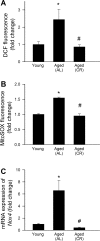Caloric restriction confers persistent anti-oxidative, pro-angiogenic, and anti-inflammatory effects and promotes anti-aging miRNA expression profile in cerebromicrovascular endothelial cells of aged rats
- PMID: 24906921
- PMCID: PMC4121647
- DOI: 10.1152/ajpheart.00307.2014
Caloric restriction confers persistent anti-oxidative, pro-angiogenic, and anti-inflammatory effects and promotes anti-aging miRNA expression profile in cerebromicrovascular endothelial cells of aged rats
Abstract
In rodents, moderate caloric restriction (CR) without malnutrition exerts significant cerebrovascular protective effects, improving cortical microvascular density and endothelium-dependent vasodilation, but the underlying cellular mechanisms remain elusive. To elucidate the persisting effects of CR on cerebromicrovascular endothelial cells (CMVECs), primary CMVECs were isolated from young (3 mo old) and aged (24 mo old) ad libitum-fed and aged CR F344xBN rats. We found an age-related increase in cellular and mitochondrial oxidative stress, which is prevented by CR. Expression and transcriptional activity of Nrf2 are both significantly reduced in aged CMVECs, whereas CR prevents age-related Nrf2 dysfunction. Expression of miR-144 was upregulated in aged CMVECs, and overexpression of miR-144 significantly decreased expression of Nrf2 in cells derived from both young animals and aged CR rats. Overexpression of a miR-144 antagomir in aged CMVECs significantly decreases expression of miR-144 and upregulates Nrf2. We found that CR prevents age-related impairment of angiogenic processes, including cell proliferation, adhesion to collagen, and formation of capillary-like structures and inhibits apoptosis in CMVECs. CR also exerts significant anti-inflammatory effects, preventing age-related increases in the transcriptional activity of NF-κB and age-associated pro-inflammatory shift in the endothelial secretome. Characterization of CR-induced changes in miRNA expression suggests that they likely affect several critical functions in endothelial cell homeostasis. The predicted regulatory effects of CR-related differentially expressed miRNAs in aged CMVECs are consistent with the anti-aging endothelial effects of CR observed in vivo. Collectively, we find that CR confers persisting anti-oxidative, pro-angiogenic, and anti-inflammatory cellular effects, preserving a youthful phenotype in rat cerebromicrovascular endothelial cells, suggesting that through these effects CR may improve cerebrovascular function and prevent vascular cognitive impairment.
Keywords: aging; angiogenesis; caloric restriction; dietary restriction; senescence.
Copyright © 2014 the American Physiological Society.
Figures






References
-
- Ahluwalia A, Tarnawski AS. Activation of the metabolic sensor—AMP activated protein kinase reverses impairment of angiogenesis in aging myocardial microvascular endothelial cells. Implications for the aging heart. J Physiol Pharmacol 62: 583–587, 2011 - PubMed
-
- Asai K, Kudej RK, Shen YT, Yang GP, Takagi G, Kudej AB, Geng YJ, Sato N, Nazareno JB, Vatner DE, Natividad F, Bishop SP, Vatner SF. Peripheral vascular endothelial dysfunction and apoptosis in old monkeys. Arterioscler Thromb Vasc Biol 20: 1493–1499, 2000 - PubMed
-
- Bach MH, Sadoun E, Reed MJ. Defects in activation of nitric oxide synthases occur during delayed angiogenesis in aging. Mech Ageing Dev 126: 467–473, 2005 - PubMed
-
- Bailey-Downs LC, Mitschelen M, Sosnowska D, Toth P, Pinto JT, Ballabh P, Valcarcel-Ares MN, Farley J, Koller A, Henthorn JC, Bass C, Sonntag WE, Ungvari Z, Csiszar A. Liver-specific knockdown of IGF-1 decreases vascular oxidative stress resistance by impairing the Nrf2-dependent antioxidant response: a novel model of vascular aging. J Gerontol Biol Med Sci 67: 313–329, 2012 - PMC - PubMed
Publication types
MeSH terms
Substances
Grants and funding
LinkOut - more resources
Full Text Sources
Other Literature Sources
Medical

